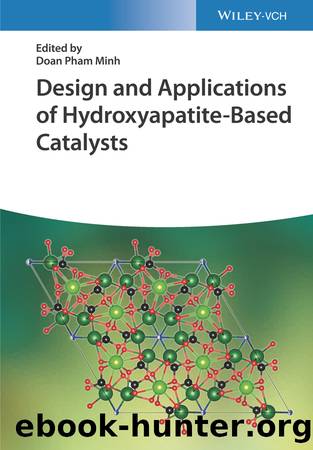Design and Applications of HydroxyapatiteâBased Catalysts by Doan Pham Minh

Author:Doan Pham Minh [Minh, Doan Pham]
Language: eng
Format: epub
ISBN: 9783527830206
Published: 2022-09-06T00:00:00+00:00
8
Reforming Processes Using HydroxyapatiteâBased Catalysts
Zouhair Boukha Rubén LópezâFonseca, and Juan R. GonzálezâVelasco
Chemical Technologies for Environmental Sustainability Group, Department of Chemical Engineering, Faculty of Science and Technology, University of the Basque Country UPV/EHU, P.O. Box 644, Eâ48080 Bilbao, Spain
8.1 Introduction
The development of clean and efficient solutions for fuels and chemicals production from fossil resources is considered one of the most important challenges facing scientific and technological research since the turn of the century. In this sense, the proven large reserves of natural gas (NG) and the development of biogas production technologies allow implementing relatively longâterm strategies for their efficient utilization. For instance, the transformation of the available natural resources into products of high addedâvalue, such as ammonia, alcohols, olefins, and higher hydrocarbons, among others, via synthesis gas (H2â+âCO), is a major challenge of the chemical industry. Moreover, owing to its clean combustion, emitting only water, and its high calorific value (120.7âkJâgâ1), hydrogen is considered as the most promising fuel to be integrated in the future energy strategies [1]. Currently, over 50 million tons of hydrogen are produced by global chemical industry for many applications [2].
The synthesis gas is mainly produced from fossil fuels by different reforming processes [1â8]. Among them, the endothermic steam reforming of methane (SRM) (8.1) is the most used one [8]. This technology has largely been applied for the production of large amounts of H2, providing a high H2/CO ratio (â¥3). However, in many cases, the exothermic methane partial oxidation (POM) (8.2) is considered a good alternative, since it offers some interesting advantages, especially when the posterior use requires an H2/CO ratio close to 2, as in the case of FischerâTropsch synthesis [8]. In the last decades, an increasing interest has also been devoted to the DRM (8.3), which appears to be a suitable strategy for long chain hydrocarbon production, which requires an H2/CO ratio close to unity [9]. For environmental concerns, this is an attractive strategy fulfilling one of the constant challenges, because it allows the use of greenhouse gases (CH4 and CO2) as reactants [4â9].
(8.1)
(8.2)
(8.3)
Due to its high symmetry, the activation of the tetravalent methane molecule through the dissociation of CH3âH bond requires a relatively high energy (439.3âkJâmolâ1) [3]. Therefore, the use of active catalysts is essential for all strategies aiming its efficient conversion by reforming processes. Noble metal catalysts, such as Rh, Pt, Pd, and Ru, exhibit a high reforming activity and good resistance to coke formation. Regarding economic considerations, current research is focused on other promising alternatives based on cheaper transition metals. Among them, judging from their high activity, Coâ and Niâbased catalysts are the most investigated ones. However, the major drawback that limits their use is their sensitivity to the structural changes under the severe conditions of the reductive pretreatment and/or during the reforming process that can in turn affect the efficiency of their active species. According to previous reports, these changes result in sintering and coking, leading to a severe drop in the activity and the resistance during a longâterm operation [4,7,8].
Download
This site does not store any files on its server. We only index and link to content provided by other sites. Please contact the content providers to delete copyright contents if any and email us, we'll remove relevant links or contents immediately.
What's Done in Darkness by Kayla Perrin(25501)
Shot Through the Heart: DI Grace Fisher 2 by Isabelle Grey(18220)
Shot Through the Heart by Mercy Celeste(18160)
The Fifty Shades Trilogy & Grey by E L James(17776)
The 3rd Cycle of the Betrayed Series Collection: Extremely Controversial Historical Thrillers (Betrayed Series Boxed set) by McCray Carolyn(13189)
The Subtle Art of Not Giving a F*ck by Mark Manson(12912)
Scorched Earth by Nick Kyme(11833)
Stepbrother Stories 2 - 21 Taboo Story Collection (Brother Sister Stepbrother Stepsister Taboo Pseudo Incest Family Virgin Creampie Pregnant Forced Pregnancy Breeding) by Roxi Harding(11040)
Drei Generationen auf dem Jakobsweg by Stein Pia(10217)
Suna by Ziefle Pia(10186)
Scythe by Neal Shusterman(9263)
International Relations from the Global South; Worlds of Difference; First Edition by Arlene B. Tickner & Karen Smith(8609)
Successful Proposal Strategies for Small Businesses: Using Knowledge Management ot Win Govenment, Private Sector, and International Contracts 3rd Edition by Robert Frey(8419)
This is Going to Hurt by Adam Kay(7696)
Dirty Filthy Fix: A Fixed Trilogy Novella by Laurelin Paige(6453)
He Loves Me...KNOT by RC Boldt(5805)
How to Make Love to a Negro Without Getting Tired by Dany LaFerrière(5378)
Interdimensional Brothel by F4U(5305)
Thankful For Her by Alexa Riley(5162)
